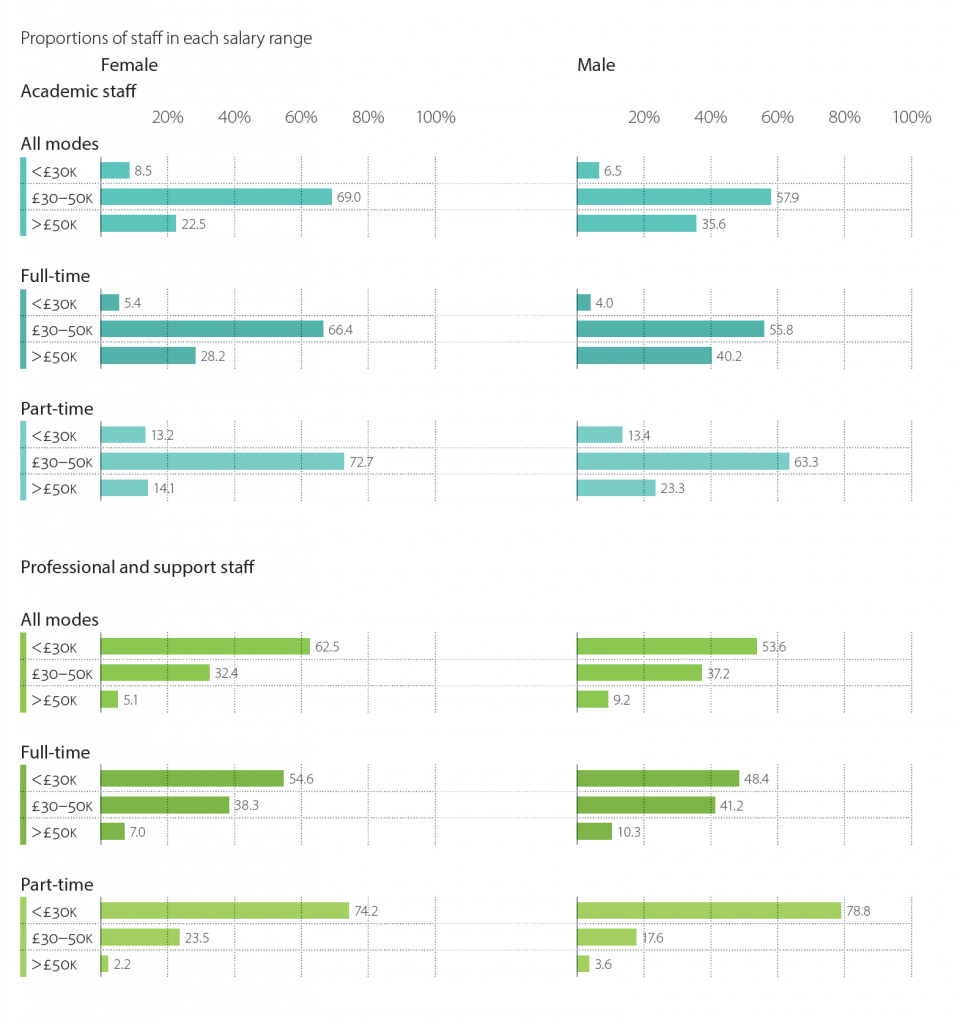Advance HE Staff Statistical Report 2018: in brief
By Gillian Mackenzie, on 30 November 2018
Advance HE Staff Statistical Report 2018: in brief
Produced by Astrea Policy team, part of the Astrea steering committee, November 2018.
This briefing summarises some of the key findings on gender and ethnicity from Advance HE’s most recent staff statistical report.
i) Headlines
- Only one in four professors were women
- Of these female professors, 91.6% were white, with only 8.4% identifying as BME.
- 6% of UK professors were black
- Only 1 in 5 female academics earned over £50,000 (22.5% of female academics, compared to 35.6% of male academics)
A. Ethnicity
ii) General trends
- Staff working in higher education have increasingly become more ethnically diverse; an increase in BME staff is most pronounced among academics.
Table 1: Proportion of UK BME staff
| 2003/04 | 2016/17 | |
| All staff | 4.8% | 7.6% |
| Professional and support staff – UK BME | 4.8% | 8.4% |
| Academic staff – UK BME | 4.8% | 6.7% |
| Professional and support staff – non-UK BME | 2.4% | 2.9% |
| Academic staff – non-UK BME | 5.6% | 8.3% |
iii) Key points
- Senior management: there are lower proportions of BME academic staff (0.4% UK BME staff, 0.1% non-UK BME staff) in senior management positions compared to white academic staff (0.8% UK white staff, 0.2% non-UK white staff)
- Heads of institution: 0.8% of UK heads of institutions were BME – a drop from 1.6% in 2015/16
- BME professors: 11.2% of white academics and 9.7% of BME academics were professors.
- 9% of non-UK white academics were professors compared with 3.7% of non-UK BME professors
- There were notable differences within BME groups: e.g. 15.8% of UK Chinese academics were professors compared with 4.6% of UK black academics
- 2% of non-UK black academics were professors
- Ethnicity pay gap: the median and mean ethnicity pay gaps between UK white and UK BME staff stood at 2.0 and 2.4 percentage points, respectively.
- There are lower proportions of BME staff on higher salary bands.
- The median and mean ethnicity pay gaps were wider among non-UK staff (8.5 and 12.4 percentage points, respectively).
- The median and mean ethnicity pay gaps were particularly pronounced between BME and white non-UK professional and support staff (13.7 and 12.6 percentage points, respectively) compared with UK professional and support staff (-1.3 and 3.0 percentage points, respectively)

Figure 1: Proportion of BME staff, 2003/04-2016/17

Figure 2: Salary ranges for professional / support staff

Figure 3: Proportion of male and female staff, 2003/04-2016/17
B. Gender
i) General trends
- In 2016/17, 54.2% of staff working in UK higher education were women (an increase from 52.4% in 2003/04) and 45.8% were men.
- The proportion of professional and support staff who were women has remained relatively constant from 62.2% in 2003/04 to 62.6% in 2016/17.
- Women comprise the majority of staff working in UK higher education, but are underrepresented among academic staff and in senior management roles.
ii) Key points
- Heads of institution: 24.3% of heads of institutions were women
- Senior management: 54.1% of professional and support staff managers, directors and senior officials were women. For both academic and professional and support staff, women were underrepresented in senior positions and overrepresented in junior positions.
- Women professors: 24.6% of professors were women compared to 75.4% of men.
- Gender pay gap: The median and mean gender pay gaps for UK professors were 5.7 and 5.9 percentage points, respectively
- Among academic staff, 22.5% of women earned over £50,000 compared with 35.6% of men.
- the gender pay gap was higher among non-professors (an overall median pay gap of 11.1 percentage points and a mean pay gap of 12.2 percentage points).
- Amongst professional and support staff, where 5.1% of women earned over £50,000 compared with 9.2 % of men.
C. How does UCL compare?
- Proportion of BME staff: 12.28% of UCL academic staff are BME; 23.8% of UCL professional services staff are BME[i]
- Proportion of male and female staff: 52.6% of UCL staff are female (and 47.4% male)[ii]
- Gender pay gap: Our mean gender pay gap at UCL is 17.5% according to data published today; this has fallen from 19.5% in 2013 and is close to the UK average of 18%.[iii]

Figure 4: Salary ranges for female and male staff
[i] https://www.advance-he.ac.uk/sites/default/files/2018_HE-stats-report-staff.pdf. All data and graphics taken from the report.
[iii] https://www.ucl.ac.uk/human-resources/sites/human-resources/files/c_staff_numbers_by_gender_and_faculty_areas_1.pdf
 Close
Close


